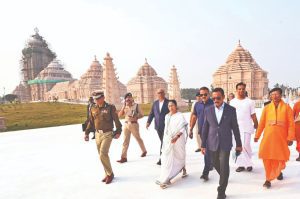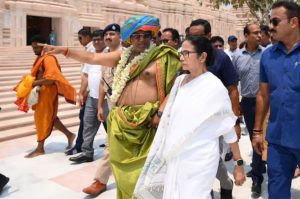West Bengal CM Mamata Banerjee’s visit to the Digha Jagannath Temple and her meeting with BJP leader Dilip Ghosh sparks political, cultural, and economic conversations ahead of the temple’s April 30, 2025 inauguration.
West Bengal Chief Minister Mamata Banerjee’s recent visit to the under-construction Jagannath Temple in Digha has ignited a wave of political and cultural discourse. Her presence at the site—coinciding with the upcoming inauguration on April 30, 2025, which falls on Akshaya Tritiya—has not only highlighted the state’s religious engagement but also made headlines due to her brief yet significant meeting with BJP leader Dilip Ghosh.
The temple, inspired by the grand Jagannath Temple of Puri in Odisha, is positioned to become a spiritual landmark in coastal West Bengal. With Lord Jagannath revered deeply across the state, especially among the Vaishnavite sects, the project represents a fusion of devotion, regional pride, and political calculation.
Political Reactions: Criticism, Caution, and Calculations
Mamata’s temple visit and her interaction with Dilip Ghosh did not go unnoticed. The BJP criticized her actions as electoral tokenism, accusing her of trying to court Hindu voters after years of what they termed as “minority appeasement.” Senior BJP leaders pointed out the contrast between her current posturing and her earlier distance from overt religious displays.
Dilip Ghosh, who has been a vocal critic of the TMC regime, adopted a more nuanced tone. He described the meeting as respectful and within the sanctity of the temple space, signaling a rare moment of civility amid deep political rivalry. Meanwhile, opposition parties like the CPI(M) and Congress accused both BJP and TMC of indulging in competitive communalism.
Social media platforms lit up with reactions, from praises about political maturity to memes hinting at unlikely political alliances. While official party lines downplayed the significance of the encounter, the symbolism was powerful: a public handshake between two of Bengal’s most polarizing figures inside a sacred Hindu space.
Economic and Tourism Impact: Digha’s Transformation into a Religious-Cultural Hub
Beyond the political optics, the Digha Jagannath Temple is expected to drive massive economic benefits for the region. The West Bengal government is developing the surrounding infrastructure to accommodate an expected annual footfall of over five million devotees and tourists. Roads are being expanded, new hotels are being constructed, and public amenities are being upgraded.

The government envisions the site as not just a pilgrimage center but a cultural tourism hub. Plans for an annual Rath Yatra have already been announced, aimed at emulating the grandeur of Puri’s chariot festival. Self-help groups, especially those led by women, will be given preference in operating temple-linked stalls, aligning the initiative with grassroots empowerment schemes like Lakshmir Bhandar.
Real estate in the region has seen a sharp rise in value, and local youth are being trained under the Skill India initiative to tap into job opportunities. The ripple effects of this development are expected to impact sectors ranging from transport to handicrafts.
The Mamata–Dilip Encounter: Symbolism, Optics, and Political Signals
The Mamata–Dilip meeting at the temple site has become one of the most talked-about political moments of 2025. In a state where political rivalries are sharp and often bitter, the cordial exchange of greetings between the TMC supremo and the BJP strongman stood out.
For Mamata Banerjee, the optics served multiple goals: showcasing leadership above party lines, reaching out to Hindu voters, and countering the BJP’s narrative of religious exclusivity. For Dilip Ghosh, the encounter offered an opportunity to demonstrate civility without compromising his ideological stance.
Analysts view this moment as part of a broader political choreography. Whether it signals potential de-escalation between the two camps or is simply a symbolic act of grace, it has succeeded in reframing public perceptions. It shows that even in the age of hyper-polarization, moments of mutual respect and shared cultural heritage can offer a reprieve.
Beyond Faith: The Digha Jagannath Temple and Mamata Banerjee’s Political Legacy
The Digha Jagannath Temple project is now etched into Mamata Banerjee’s political narrative. It reflects her evolving strategy to integrate religious identity with cultural and economic aspirations. Unlike the secular rigidity of the Left or the majoritarian thrust of the BJP, Mamata’s model represents a hybrid vision—a fusion of inclusive governance and rooted spirituality.
By aligning herself with the temple project, she positions herself as a cultural custodian, a unifier in polarized times, and a development-oriented leader. The meeting with Dilip Ghosh only enhances this multifaceted image.


As the temple opens on April 30, it stands not just as a religious monument but as a political, economic, and social symbol. For Mamata Banerjee, it may well become a cornerstone of her legacy—a testament to her ability to blend culture with strategy, devotion with governance, and tradition with transformation.
Mamata Banerjee’s Digha Jagannath Temple Visit 2025: ISKCON and the Soft Power of Religious Diplomacy
A particularly notable aspect of Mamata Banerjee’s involvement in the Digha Jagannath Temple project is her decision to include senior ISKCON (International Society for Krishna Consciousness) leadership in the temple’s advisory and administrative framework. Among those named is Radharamn Das, the Vice President of ISKCON Kolkata, who will now serve on the temple’s board of trustees. This strategic inclusion is not merely symbolic—it signals Banerjee’s outreach to globally recognized Hindu organizations and her attempt to anchor the temple within an internationally credible religious network.


ISKCON, which has its roots in the Gaudiya Vaishnavism tradition that originated in Bengal itself, enjoys both national and international reverence. With temples and devotees in over 150 countries, the organization’s participation in the Digha temple lends it both spiritual authority and international legitimacy. It also links the temple with the teachings of Chaitanya Mahaprabhu, a 15th-century Bengali saint and a revered figure in the Vaishnava tradition, thereby reinforcing its Bengal-centric spiritual identity.
This move also comes against the backdrop of growing concerns about the safety of ISKCON institutions and devotees in neighboring Bangladesh. Several recent attacks on ISKCON temples, including incidents of vandalism and violence against monks, have prompted international outcry and concern among Hindu organizations. By extending an olive branch to ISKCON and incorporating them into state-backed religious projects, Mamata Banerjee appears to be making a diplomatic gesture—acknowledging the pain of persecuted Hindus abroad while reinforcing her commitment to protecting religious freedom within West Bengal.
This serves two purposes. First, it positions her as a protector of minority Hindu institutions in a broader South Asian context, subtly countering accusations from the BJP that she has historically ignored the interests of the Hindu community. Second, it allows her to gain goodwill from a large and influential spiritual organization without directly indulging in sectarian politics.
In addition, ISKCON’s strong urban and international appeal could help improve the temple’s brand value, making it attractive not just to rural devotees, but also to diaspora communities, domestic tourists, and international visitors. With ISKCON’s participation, the temple project transcends its regional roots and enters the domain of global Hindu spiritual tourism.
Banerjee’s ability to include ISKCON without stirring overt religious controversy demonstrates her political acumen in balancing religious symbolism with secular governance. It also adds a layer of soft power to the temple project—positioning it as not just a religious endeavor, but a global cultural asset rooted in Bengal’s spiritual heritage.
Political Reactions: Criticism, Caution, and Calculations
Mamata Banerjee’s high-profile visit to the under-construction Jagannath Temple in Digha, especially her brief encounter with BJP leader Dilip Ghosh, has triggered a wide spectrum of political responses. While supporters within the Trinamool Congress (TMC) hailed it as a “moment of inclusive governance,” critics—particularly from the Bharatiya Janata Party (BJP)—were quick to raise suspicions about the Chief Minister’s motives.
The BJP’s local and central leadership reacted with cautious skepticism. Many interpreted Banerjee’s visit and symbolic offerings as attempts to reclaim the Hindu vote bank, which the BJP has steadily courted in West Bengal over the last few election cycles. Some senior BJP leaders have alleged that Banerjee’s religious posturing is “electorally motivated” and accused her of hypocrisy—pointing to past instances where she had avoided overt participation in Hindu rituals while vocally supporting festivals of other communities.
Dilip Ghosh himself, who was present at the temple site and briefly met the Chief Minister, chose his words carefully. In post-event interviews, he acknowledged the cordiality of the meeting but downplayed its political significance. “I went to offer my respects at the Jagannath Temple. It’s a place of devotion, not politics,” Ghosh said. However, his calm demeanor stood in stark contrast to the fiery rhetoric he has previously used against the TMC government, especially on issues related to religious freedom and minority appeasement.
For the BJP, the optics of Mamata Banerjee visiting a temple they had vocally supported during the foundation stage—only to take over the project later under full state sponsorship—presents both a challenge and an opportunity. On one hand, it shows that the TMC is willing to incorporate Hindu iconography into governance, weakening the BJP’s claim of being the sole representative of Hindu interests in Bengal. On the other hand, the BJP is attempting to frame Banerjee’s actions as “damage control” and “politically driven repentance,” in an effort to discredit her shift as insincere.
Smaller opposition parties have also entered the fray. The Congress and the Left Front have accused both the TMC and the BJP of engaging in “competitive communalism.” They argue that state funds should not be used for constructing religious institutions, regardless of which faith they represent. CPI(M) leaders have criticized the trend of blending religion with development, warning that it could deepen social divides rather than heal them.
Civil society, meanwhile, is divided. While some secular voices have raised concerns about the state’s increasing involvement in religious affairs, others view the temple project as a legitimate cultural initiative that could stimulate regional development and boost the economy through tourism.
Amid all this, Mamata Banerjee has remained steadfast. She has emphasized that the temple is not just a place of worship but a cultural milestone for Bengal—a place that will offer spiritual solace, economic opportunity, and regional pride. Her repeated references to peace, unity, and “Bengali cultural resurgence” are part of a broader narrative aimed at softening political polarization through a shared sense of heritage.
Economic and Tourism Impact: Digha’s Transformation into a Religious-Cultural Hub
Beyond the political and religious symbolism, the Digha Jagannath Temple is poised to become a significant driver of regional development and economic upliftment. Digha, traditionally seen as a modest beach town catering to middle-income tourists from West Bengal and Jharkhand, is now on the brink of a substantial transformation into a spiritual-cultural hub—thanks to this ambitious temple project.
The West Bengal government has invested heavily in complementary infrastructure to support the anticipated surge in visitors. Roads leading to the temple are being widened and resurfaced, a new parking area with capacity for over 1,000 vehicles is under construction, and dedicated public transport routes are being planned to improve connectivity from major railway stations and bus depots. The state tourism department has also initiated talks with private hotel chains to build new accommodations in and around Digha, targeting both pilgrimage and leisure tourists.
Experts estimate that the temple, once completed and fully functional, could attract over 50 lakh (5 million) tourists annually. This will not only boost the hospitality sector but also have a ripple effect on small businesses—restaurants, souvenir shops, local artisans, and tour guides are expected to benefit substantially. In fact, the government has launched training programs under the Skill India initiative to prepare local youth for employment opportunities in the tourism and service industries.
Additionally, special emphasis is being placed on promoting cultural tourism. Plans are underway for an annual Rath Yatra (Chariot Festival) modeled after Puri’s, which will be organized with grandeur and state support. The event is expected to draw thousands of devotees from across the country, potentially rivaling the Puri Rath Yatra in spectacle and turnout. Such events can establish Digha as a permanent fixture in India’s religious tourism circuit, alongside destinations like Varanasi, Ayodhya, and Tirupati.
Local economic ecosystems are already responding. Real estate prices in the vicinity of the temple have spiked dramatically, with demand for hotels, rental spaces, and shops surging. Local farmers and fisherfolk, too, see new opportunities—through farm-to-table restaurant initiatives, cultural food stalls, and eco-tourism projects that can cater to a new kind of visitor seeking authentic rural experiences.
Moreover, Mamata Banerjee has announced that women-run self-help groups (SHGs) will be given first preference in temple-linked commercial stalls, thereby creating a sustainable and inclusive microeconomy. This move aligns with the state’s long-standing focus on empowering women through the Lakshmir Bhandar scheme and other livelihood initiatives.
From the government’s perspective, the temple serves as both a spiritual beacon and an economic engine. The hope is that Digha will soon rival Puri—not just in religious fervor, but also in the sheer volume of tourist footfall and the scale of economic activity generated. If successful, it could become a model for replicating similar development-driven religious infrastructure projects across the state.
Jagannath Temple – Official Puri Website
As the April 30 inauguration approaches, all eyes will be on the Digha Jagannath Temple—not just as a place of worship, but as a litmus test for the evolving political grammar of West Bengal. It is a temple built with bricks and belief—but also strategy, symbolism, and the unmistakable imprint of Mamata Banerjee’s political genius.
Also read: Home | Channel 6 Network – Latest News, Breaking Updates: Politics, Business, Tech & More

